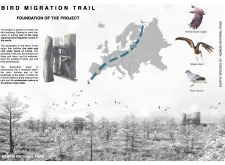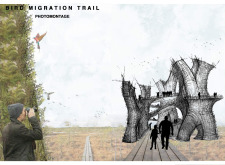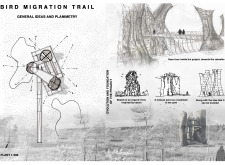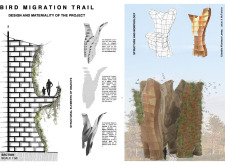5 key facts about this project
The Bird Migration Trail is an observation tower located in Latvia, known for its significance as a migration route for various bird species. The project is set within an area characterized by its proximity to seas, lakes, rivers, and wetlands, which supports a rich diversity of birdlife. The design prioritizes the relationship between the structure and the natural environment, aiming for a layout that serves both form and function while minimizing its visual impact on the landscape.
Design Concept
The observation tower is designed to provide an engaging experience for visitors. Its multi-level layout encourages exploration, with ascending walkways that lead to a lookout point. As individuals move upward, they gain better views of the surrounding wildlife. The aim is to enhance interaction with the natural world, allowing visitors to appreciate the beauty of bird migration in a purposeful setting.
Structural Composition
The main structure consists of three interconnected towers. The design incorporates vertical wooden planks that act as supports, giving the tower strength and stability. Horizontal wooden planks serve as ribs, providing volume and reinforcing the walkways. This arrangement not only helps with the structural integrity but also connects the architecture to the organic lines found in nature, creating a harmonious relationship between the tower and its environment.
Integration with Nature
A key aspect of the Bird Migration Trail is its alignment with the natural landscape. The towers have a recessed shape, which reduces their visual weight, making them appear less imposing. Gaps in the structure are intentionally filled with native plants. This vegetation blends the tower into its surroundings and supports local wildlife, including the birds that visitors come to observe.
At the top of the tower, a spacious lookout platform allows visitors to quietly watch migrating birds against the scenic backdrop of Latvia's landscapes, ensuring that the journey through the tower is as memorable as the destination itself.





















































